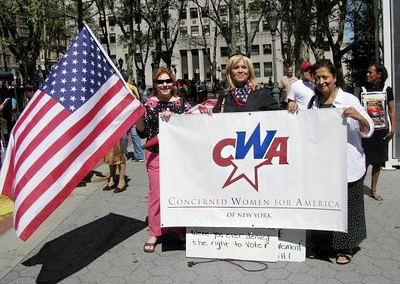Concerned Women for America (CWA) was founded in 1979 by Beverly LaHaye, wife of conservative activist—and later Left Behind co-author—Tim LaHaye. Irritated by the ascendance of Betty Friedan’s National Organization for Women (NOW), LaHaye founded CWA to represent traditionalist women who balked at feminist “liberation.” Since its inception, the group has worked to bring “biblical values” to bear on the American political process, with special attention to issues of sex and gender. Over the past three decades, CWA has become a powerful political force, claiming over half a million members.
Leslie Dorrough Smith is Assistant Professor of Religious Studies at Avila University in Kansas City, Missouri. Her book, Righteous Rhetoric: Sex, Speech, and the Politics of Concerned Women for America, published this spring by Oxford University Press, provides the first full-length analysis of CWA rhetoric. Smith situates CWA within a long tradition of American political discourse concerning sex and gender, explaining how the group’s public arguments are calibrated to best persuade their audiences.
RD’s Eric C. Miller talked with Smith about her project.
What prompted your interest in the rhetoric of American conservative Protestants (ACP), and what drew you to Concerned Women for America (CWA) in particular?
As with many scholars, I suspect, my interest was at least partly autobiographical. I grew up in an environment steeped in conservative Protestant thought, although much of my exposure to these ideas wasn’t overtly tied to politics. When I began to study religion formally and saw those strong political ties at work, I wanted to better understand the dynamics causing large numbers of people to adopt the interests of CWA and other Christian Right groups even when those ideas don’t necessarily have clear factual backing.
I felt that a thoroughgoing treatment of how public persuasion and belief formation happens had been mostly ignored in scholarship, as most scholars simply see finite groups with finite beliefs, rather than asking critical questions about how people develop sympathies for certain concepts in the first place. That was where my interest in rhetoric really began.
I thought that the best way to dissect the persuasive power of the Christian Right was to choose a particularly influential group that was not only representative of the larger movement, but one that held formidable influence over the sex and gender issues that are so central to almost every other platform that the movement supports. CWA was a natural choice: it has a noteworthy presence on conservative and other media outlets; it maintains a strong grassroots base; and, having been in existence for several decades, it has longevity on its side.
In addition, its identity as a women’s group has been a very critical part of how it promotes its authority to speak on sex and gender issues. Historically, women have been both the most vocal proponents and opponents of the liberalization of sex, gender, and reproduction laws. If we take seriously that gender – as just one of many forms of social control – is an important litmus test to gauge the power relationships in a culture, then it makes sense to focus on a group that amplifies its gendered identity as a major aspect of its authority.
Much of the book is focused on what you call “chaos rhetoric,” using CWA as a case study. What is chaos rhetoric, and how does it work?
Chaos rhetoric is my term for a type of speech that invokes widespread public appeal through its deployment of specific symbols designed to create a heightened sense of social chaos and threat (rather than the order and security that scholars often tout when describing the Christian Right).
By carefully manufacturing these negative emotions, the group is in a prime position to offer its own political platforms as the resolution to the threats that they construct. One could simply call chaos rhetoric a fear tactic, but I thought this was too simplistic, since I was more interested in looking at how, when, and under what circumstances CWA chose to portray certain things as chaotic or fearful rather than presuming that those emotions were self-evident or natural. In other words, what is deemed frightening or threatening at one moment is often a non-event several years, or even months, later – it all depends on how the political and cultural winds are blowing.
Yet chaos rhetoric is a technique not only of persuasion, but also of masquerade. In the book I detail how chaos rhetoric serves four critical functions, two of which – creating urgency and inciting activism – are fairly predictable persuasive techniques. But CWA’s chaos rhetoric also performs the dual functions of defensive argumentation and rationale-deflection, which are processes by which attention is shifted away from CWA and its perhaps less popular rationales for advocacy and onto more emotion-evoking platforms.
These are both really effective ways for the group to change more imperceptibly simply by convincing the audience to concentrate elsewhere.
For example, CWA has frequently attempted to portray homosexuality as a public health threat, which it has done through studies that show things like an elevated risk for domestic violence among gay couples, or that pinpoint elevated suicide rates among gay teens. Rather than describe the more subjective discomfort that characterize its members’ homophobia, or talk about theologies of homophobia (neither of which is a particularly persuasive tactic if the point is to attract a diverse audience), CWA persuades best by portraying homosexuality as a threat to something that virtually everyone values—their health.
Deflecting the rationale from religious particulars or gut feelings onto a more “legitimate” concern helps to make the message sound relevant; in all honesty, if CWA were really concerned with public health issues, then they’d be discussing more than just the health risks associated with homosexuality. Moreover, focusing attention on its opponents (but less on itself) allows CWA to shift its own agendas more imperceptibly.
As the message about gay rights as a health threat grows stale, loses public appeal, or is otherwise debunked, it is abandoned for a new one that accomplishes a similar effect. But once the similar effect is no longer possible to maintain, the group will be pushed to rework its stance on homosexuality, even if incrementally, so as to preserve its public relevancy. In this case, that might mean the shift from seeing homosexual identity as a sin to regarding the practice of homosexuality as a sin – that nuance, however slight, provides some wiggle room that gives the group material to work with in crafting new rhetoric.
What this shows, then, is that the real persuasive force of chaos rhetoric lies in knowing how to repeatedly rework an opponent’s identity so that they remain perpetually threatening, and crafting one’s own rationale so that it always seems relevant.
You mention that other scholars have associated conservative Protestant speech with “order and security.” But you see it as very flexible and adaptable.
Yes – and here I think that scholars have tended to confuse these groups’ self-perceptions and public portrayals with the sociological dynamics that are actually sustaining them. While I think it’s true that Christian Right groups are attractive to the public because they provide the sense of a high degree of order and stability in times of change (which is something that many scholars argue), I think that there’s more going on under the surface that’s quite pliable and dynamic.
As the previous discussion on chaos rhetoric shows, I’m interested in how CWA uses a series of rhetorical techniques that permits them to continuously shift their platforms as is politically expedient, leaving little that is actually stable about them over time, even as they continue to promote the eternality of their claims. Many have also noted this trend, and usually they describe these changes as smaller or peripheral in light of a rigidly maintained core. Others have simply called it hypocrisy.
Neither one of these explanations was satisfying to me, however, as they did not seem to acknowledge the gravity of the shifts that are often taking place, nor the normalcy (and necessity) of this practice to maintain social relevancy and thereby incite public persuasion. For instance, in the 1960s and 70s, CWA’s founder, Beverly LaHaye, wrote extensively about the dangers of working motherhood, for she saw it as a feminist ploy to literally destroy families and create gender-free societies run by socialist governments.
But as working motherhood became much more common and accepted, the organization now discusses working motherhood as a positive thing so long as one finds a balance between personal and professional commitments. Rather than see this as a small tweak or minor issue, this is actually a change of great magnitude, for it involves CWA having to publicly re-work major facets of its own philosophy on gender in ways that directly interrogate some of its older, most basic, claims. The point is that all groups that seek to remain persuasive must also remain relevant, and this is an especial challenge for groups that have a lot of social capital built up in the appearance that they hold strong, eternal platforms.
CWA uses that flexibility to infiltrate and co-opt other important symbols, to suggest that they represent the true family, the true America – even the true feminism.
CWA’s ability to deploy strong, emotional symbols in such a way that they can transform themselves into whatever image is powerful at the moment is, in my mind, the group’s greatest distinction.
In particular, though, its claim to the term “feminism” was one of the more surprising elements of my research, and it really exhibits the pliability and dynamism that I mentioned above. As CWA tells the story, the organization first began as a campaign against liberal feminism, and for most of its history, it has portrayed feminism as destructive and immoral. Despite this, over the past few years CWA has begun to describe itself as the embodiment of “true,” or conservative, feminism. It does this by locating itself within a long lineage of nineteenth- and early twentieth-century Christian female activist groups organized to clean up sin in American culture, calling these women the “original” feminists.
The likely reason for this switch is that it’s attempting to appeal to a younger crowd that takes many of the social advances of 1960s-70s feminism for granted. Not surprisingly, over the past several years the organization has started to target its rhetoric at younger women who don’t necessarily find that term objectionable. In other words, it’s a smart marketing move.
Of course, this is frustrating for those of us who identify as feminists, but as I’ve mentioned earlier, using your opponent’s symbols for your own gain is a really normal tactic that all groups perform, liberal advocacy groups included. So if we’re looking for a source of distinction that sets CWA or the Christian Right apart from other social movements, we won’t find it here.
You offer many examples of CWA speakers and writers being tricky or manipulative in their arguments, but ultimately you conclude that they aren’t really different from other advocacy groups in this respect.
I wouldn’t use the words “tricky” or “manipulative,” because those words imply that there’s a certain moral ineptness inherent in chaos rhetoric. What I’d claim, rather, is what I said earlier: most of us tolerate chaos rhetoric quite well when it’s being used by a group that we like. In other words, various methods of persuasion (in this case, chaos rhetoric) are called “tricky” or “manipulative” only when a group that we don’t favor shows up to the party.
And that, really, is much of the point of the book, wherein I grapple with whether chaos rhetoric is a unique practice. I demonstrate that it’s not, as I show how many other, seemingly different, groups (including the very scholars who study the Christian Right) do the very same thing: they use chaos rhetoric to portray their own ideological opponents as a force that violates everything that is good, noble, productive, etc. so that they can represent their own perspectives as more logical or mainstream.
It may seem on the surface that scholars would be very unlikely to use chaos rhetoric, since they are supposed to maintain a degree of scholarly objectivity that others don’t employ. What I try to show is that this is not the case at all, for scholars have their own agendas that they use to formulate the very categories that make their analyses possible. Sometimes this happens in more overt ways, as when one finds a statement at the end of a book on the Christian Right wherein the scholar reassures the reader that, while his/her analysis has been objective, the Christian Right should nevertheless be feared and opposed, for it represents a force antithetical to true democracy, liberty, and diversity. Whether or not one concludes that this is accurate is beside the point, for this is still chaos rhetoric at work.
To be very clear, this is not my statement in support of CWA, the Christian Right, and/or conservative politics. It is also not a statement on the ethics of chaos rhetoric. My point is simply that chaos rhetoric is not only very effective, but it is also ubiquitous. Almost everyone who wants to persuade will end up using it at some point or another, and this reality pushes an important question: if chaos rhetoric is a central tool in garnering political power, and if it is absolutely everywhere, then what really sets apart Christian Right groups from others? While I believe that there are some elements of distinction held by the Christian Right, on the whole, I think that they’re rather ordinary. What is extraordinary about them is their ability to easily manipulate so many symbols at one time in a way that most other groups can’t.
Do you think Christian advocates should be held to higher standards of honesty than other political organizations, if only because they claim Christian values?
This question presupposes that chaos rhetoric represents something inherently dishonest. Obviously, though, it’s possible for a strong message to be deemed accurate just as much as it is for it to be deemed inaccurate. I’m also wondering why we presume that Christians have a greater moral obligation than any other group. This, to me, is one way that American society grants authority to religious groups in such a way that they don’t even have to work for it: we equate religiosity with morality.
While I realize that Christian (and other religious) groups often openly tout their moral prowess, I tend to see this as a form of social advertising – a tactic to reinforce their authority – rather than a statement of actual difference.
It would be nice to know that what we hear from public groups are always accurate renderings of factual events, but since reality is often muddy, subjective, and nuanced, this implodes the idea that there’s a clear “moral” platform on which we all can agree. There’s also the basic sociological fact that Christians exist in culture, and so as cultural players, engage in cultural acts. Producing chaos rhetoric is a very normal cultural act because it’s an effective way to gain authority and support, which is necessary for any social group to survive. Expecting groups to exist outside of the very culture on which they rely to survive is asking them to perform cultural suicide.
So do I wish it were different? Certainly. But I’m not sure that my wish is practical, given the ways that society works.





